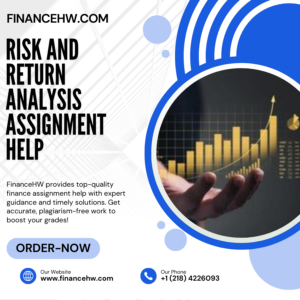Can I hire someone to help with portfolio Risk and Return Analysis?
Can I hire someone to help with portfolio Risk and Return Analysis? The key functions of Risk and Return Analysis
Finance is an intricate subject that demands extensive research and comprehension, Risk and Return Analysis so homework experts offer well-structured assignments with clear statements, abstracts and logical arguments for better comprehension as well as relevant facts such as charts, tables and figures.
Systemic risk, which affects all market sectors simultaneously and cannot be reduced through diversification measures alone, includes factors like interest rates, recession and wars.
Systematic risk is an existential threat to our economy and financial system. It refers to the possibility that an event affecting multiple financial institutions could trigger their collapse, leading to market instability. Individual company and market risks can usually be managed through diversification by creating an asset portfolio with multiple assets, but systemic risk remains unavoidable, which cannot be completely avoided by investors.
The first dimension of systematic risk involves common exposures and interlinkages within the financial system. Interdependencies within this ecosystem create situations in which one shock can have far-reaching and devastating repercussions; FinanceHW this phenomenon has come to be known as “too big to fail”, meaning large, interlinked financial institutions are more likely to collapse than smaller, less connected ones.
As larger institutions have more liquidity and can quickly raise funds during adverse events, their failure can have a ripple effect, prompting even more to follow suit and fail. A failure by one large financial institution is often seen as creating economic uncertainty and can even cause stock prices to drop significantly, as was seen when Lehman Brothers collapsed in 2008.
Procyclicality risk is another element of systematic risk, highlighting how systemic risk can become self-reinforcing, exacerbating boom and bust cycles while undermining financial and macroeconomic stability. Therefore, governments should exercise caution when adopting aggressive monetary policies.

The last dimension of systematic risk relates to interest rate markets. This type of risk mostly affects bonds and other fixed income securities and can arise from changes in interest rates or due to dividend reinvestment and income streams. When making investment decisions, it’s essential to remember the effects of changes in interest rates; changes can have a dramatic effect on performance due to their direct correlation to stock Prices.
When writing finance assignments, it is vital to demonstrate an in-depth knowledge of risk and return.
Risk and return are fundamental concepts in financial analysis, used to evaluate Investments, portfolios, and other assets. For a deeper understanding of this subject matter, students should familiarize themselves with different metrics that quantify these factors.

Risk and return are integral components of investing. Investments with higher return potential tend to come with more risk, but this tradeoff depends on individual preferences, time horizons and investment goals. Risk-return analysis helps investors select investments that match their preferred risk tolerance levels while understanding how different kinds of risks impact returns – systematic risks inherent to markets that cannot be hedged off through diversification; unsystematic risks specific to companies or industries –
Investment return refers to the monetary gain that an investment produces over time, whether through dividends from shares or coupons from bonds, capital growth or both. Investors usually view it as a percentage of their initial investment amount; investors often use scatter plots for this analysis of risk and return.
Investing involves inherent Risk, and no strategy can eliminate it completely. While some investments prove highly successful, others fail. But diversification can reduce your exposure while providing better returns than would otherwise be available to you.
Diversifying is key for mitigating major losses and can be measured using standard deviation (SD).
Diversification is one of the best strategies for mitigating risk and volatility, although it won’t eliminate all threats to capital. Diversification works by diversifying across various asset classes such as stocks, bonds, real estate CDs and cash – these assets perform differently during different economic conditions and can help lessen certain forms of market risk exposure.
Modern portfolio theory is a statistical method for optimizing investment returns based on risk and is an indispensable Resource for risk-averse investors seeking to minimize losses while optimizing returns.
Diversification is encouraged among securities and asset classes; experts maintain that diversifying your portfolio reduces its risk. Stocks tend to be more volatile than bonds; therefore they should be offset with stable investments like cash or real estate for maximum balance.
However, this strategy has some drawbacks. First of all, it assumes the market possesses all of the information needed to assess a company’s stock performance – this assumption may be compromised by nonmarket factors and ignores unsystematic risks specific to individual securities or sectors that can be reduced with diversification. Finally, MPT portfolios tend to rely heavily on diversification; many investors are moving away from them in favor of more diversified and “riskier” portfolios which may provide greater efficiency overall.
Market analysis is an intricate process of asking pertinent questions, exploring data in depth, and developing insights into strategy. To conduct it successfully, it’s essential that you set clear goals and determine your purpose of analysis to avoid getting bogged down with irrelevant details. You might, for instance, wish to understand market size for a new product or benchmark its performance against rivals; or discover potential Growth Rates through customer surveys, industry reports, and interviews with experts.
Market analysis shouldn’t just be performed by your marketing department – all departments of your organization should collaborate to ensure insights align with business goals. Sharing results during team meetings will foster alignment and make turning data into action easier. Furthermore, set up processes that allow quick responses to changes in the market.
Finance can be an intricate subject to grasp. Students often turn to StudyGate experts for help with their homework – those who specialize in finance themselves so that even complex concepts are explained clearly and simply.
Risk and return analysis is an increasingly challenging topic to grasp, so here’s how you can get help with your finance Homework.

Financial assignments can be a complex challenge for students. To succeed at them, students need an analytical mind, willingness to accept responsibility, and decisiveness when taking decisive actions. Furthermore, students should possess an in-depth knowledge of underlying financial concepts as well as how these apply in solving homework problems. Many seek personal finance assignment help online in order to master these complex assignments and stay on the right path with their studies.
Our experts are fluent in finance language and hold advanced degrees in their respective subject areas, making them adept at breaking down complex concepts and theories to ensure real world implementation and student success. They can break down assignments for students to ensure complete support to help ensure success!
Assignment assistance includes cash flow, statement of Cash Flows, capital structure, stock valuation, risk management, bond valuation and the cash conversion cycle. We can even help with more complicated matters such as amalgamation; that process of merging companies together into one entity. Our experts can assist with any finance problem you might be having – just reach out!
Finance assignments often require extensive research, analysis and writing – tasks which can be especially taxing on students with multiple subjects to manage. With professional finance assignment help from services like The Assignment Experts at your service you can avoid missing deadlines and losing points due to missing assignments that are original and well researched.
Finance experts can assist in breaking down complex concepts into manageable parts and provide clarity on topics like discounted cash flow analysis, risk evaluation and portfolio optimization. Furthermore, they can improve academic performance by offering personalized assistance and guaranteeing that work produced is free from plagiarism or grammatical errors.
Additionally, they can help you understand your weak areas so you can work to strengthen them, increasing both academic performance and future preparedness for financial analyst careers. By helping you navigate Challenging concepts more easily in life as an analyst.
Finance can be an arduous subject and often requires extensive research, so many students seek online finance assignment help from experts like ours. With years of experience behind them, they’re more than capable of providing assistance for any assignments you might be struggling with.
No matter if it be risk and return or investment analysis, our team is here to assist. We know how difficult writing a finance paper can be and we do our utmost best to make life easier for you.
Our team of experts use clear, simple language to explain complex concepts. Additionally, they ensure your papers comply with all academic standards. Our goal is to offer the highest-grade finance homework help so that you can achieve top marks on exams. We take great pride in upholding integrity and helping students reach their goals; rest assured that any assignments provided to you by us will always be original without plagiarization issues!
Can I hire someone to help with portfolio Risk and Return Analysis? The key functions of Risk and Return Analysis
How do I find someone to help with both qualitative and quantitative aspects of Risk and Return Analysis? I recently
Where can I find someone with knowledge of finance for Risk and Return Analysis homework? With a detailed context provided
How do I ensure the person I hire has go to this site in Risk and Return Analysis? In this
What should I provide to someone doing my Risk and Return Analysis homework? Frequently asked questions Hello, I am working
Can someone show me how to interpret Risk and Return Analysis data? It seems like every analyst (aka analyst) has
How do I give detailed instructions to someone doing my Risk and Return Analysis homework? A friend started doing Risk/Return
Is hiring someone to do my Risk and Return Analysis homework ethical? There are probably a couple of things I
How can I find someone who can work on Risk and Return Analysis homework urgently? A professional risk and returns
How do I negotiate a price for Risk and Return Analysis homework help? If this question is the first question
Struggling with finance concepts? Let FinanceHW help—reach out now for expert aid!
FinanceHW provides top-notch finance assignment help with accuracy, reliability, and timely delivery!

![]()

Copyright © All rights reserved | Finance HW